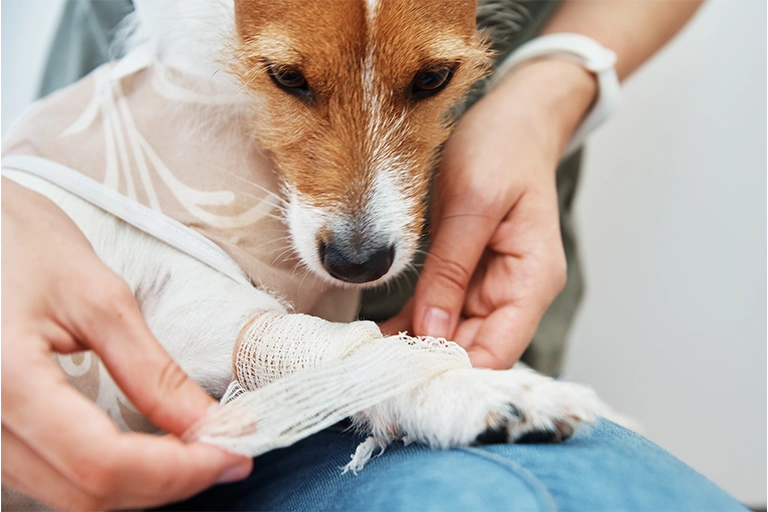Have you ever found your dog constantly licking its paws?
You wonder why this happens.
In this post, you are going to explore effective solutions that can stop this behavior.
Why Dogs Lick Their Paws?
Licking paws are related to many factors. It includes dermatological conditions, allergies, behavioral issues, and inflammation.
One common dermatological condition that can cause dogs to lick their paws is atopic dermatitis (AD). AD is a chronic relapsing pruritic skin disease that affects dogs (Olivry et al., 2010).
Dogs with AD may lick their paws as a way to alleviate the itching.
Before we dive into the solutions, let’s first understand why your dog is licking their paws.
Allergies
Dogs can be allergic to a variety of things in their environment.
Allergens such as environmental allergens like pollen, Staphylococcus bacteria, and Malassezia yeast can trigger flares of atopic dermatitis and lead to paw licking (Olivry et al., 2010).
These allergies often create an itchy skin. This causes your dog to lick their paws for relief.
Also, specific foods may also trigger allergic reactions in some dogs. Make sure your dog diet is free of allergens.
In many cases, these allergies don’t result in sneezing or watery eyes.
As a result, inflammation, skin irritations and itching can be seen.
Parasites
Parasites such as fleas, ticks, and mites are common culprits.
They can wreak havoc on your dog’s skin. It causes itching and irritation.
The paws often become the primary target for this soothing licking behavior.
These parasites can also carry diseases, causing further health problems in your dog.
Moreover, the licking might result in wounds and secondary skin infections, adding to your pet’s distress.
Therefore, it’s important to regularly check your dog for any signs of parasites.
A veterinarian can guide you in choosing the most suitable parasite prevention options.
Infections
Both bacterial and fungal infections can cause severe problems in paws.
Your dog have a natural tendency to lick or chew areas that are irritating or painful.
If you notice any changes in your dog’s paws such as swelling, discharge, foul odor, it’s important to seek veterinary care promptly.
Your vet can accurately diagnose the type of infection and prescribe appropriate treatments.
Dry Skin
Seasonal changes in weather, especially during colder months, can wreak havoc on your dog’s skin. This results dryness and subsequent itchiness.
Dry skin is more than just an aesthetic concern for our friends; it can be a considerable source of discomfort.
To alleviate this sensation, your dog may resort to licking their paws, their most accessible area. It creates a potential cycle of discomfort and licking.
Dry skin is also more susceptible to injuries and infections.
When the skin’s barrier function is compromised, it becomes easier for bacteria and fungi to cause infections.
It’s therefore important to keep your dog’s skin hydrated and healthy, especially during those colder, drier months.
You can use moisturizing ointments and dietary supplements under a vet guidance.
Pain or Injury

Inflammation and pain can also contribute to paw licking in dogs.
Studies have shown that the injection of substances into the paws of animals can induce licking behavior (Kassuya et al., 2007; Liang et al., 2011).
These substances activate pain receptors and can cause itching and discomfort, eventually leading to paw licking.
If your dog has a cut, thorn, splinter, or other injury on their paw, they’ll likely lick the area to clean and alleviate the pain.
Dogs use their tongues against wounds by cleaning the area and accelerating healing process.
However, while this behavior may be natural, it’s not always beneficial.
Excessive licking can delay the healing process. It may lead to further injury or secondary infections.
Arthritis can also lead to discomfort that your dog may try to soothe through licking.
Therefore, if you notice your dog constantly licking their paws, it’s essential to check for any visible signs of injury.
If an injury is present, ensure it’s cleaned and properly cared for to promote healing.
In cases where the cause of pain isn’t immediately visible, a trip to the vet may be in order.
Cysts
Cysts or growths can cause your dog to lick or chew paws.
It’s important if you observe any abnormal growth. you should visit a veterinarian.
Hormonal Imbalance
Hypothyroidism can also cause your dog’s skin to become dry, itchy.
We should not forget some hormonal imbalances can result in increased anxiety, another trigger for compulsive licking.
Anxiety or Boredom
Studies have shown a correlation between paw preference and behavior problems in dogs.
Dogs with behavior problems such as stranger-directed aggression, stranger-directed fear, and attention-seeking behavior may exhibit increased right-pawedness, which is associated with higher subscale scores on behavior assessments (Wells et al., 2019).
However, it is important to note that not all dogs licking their paws have some behavior problems, and the relationship between paw preference and behavior issues is complex and multifactorial (Branson & Rogers, 2006).
Dogs can experience emotional distress like anxiety or boredom.
One method is through self-soothing behaviors.
This licking serves a way for them to self-soothe and self-stimulate during anxiety or boredom.
While it may provide temporary relief, excessive licking can become a problem in itself. It potentially leads to skin infections or exacerbating existing skin conditions.
Furthermore, paw licking constantly might be your dog’s way of expressing a deeper emotional issue.
In this case, we should address these questions:
Are there any recent changes that could be causing stress?
Is your dog receiving enough mental and physical stimulation?

Habitual Behavior
Sometimes, paw licking can become a habitual behavior. This means even after the original cause has been treated like injury, allergy, or infection, your dog continues to lick their paws simply out of habit.
If you believe your dog’s paw licking has become a habit, it might be time to intervene.
Providing alternative forms of stimulation, like new toys, walking or increased exercise, can help break the cycle.
Solutions
Let’s discuss some possible solutions to stop your dog from licking their paws.
Allergies, parasites, infections, dry skin, and underlying medical conditions can all trigger paw licking.
If your dog has a visible injury, clean it thoroughly, you can apply a pet-safe antiseptic.
Please also consider using a protective bootie to prevent further licking.
In both cases, you should immediately consult with a vet to diagnose and treat these problems.
Provide Proper Nutrition

Essential fatty acids (Omega-3 and Omega-6) can contribute to skin health. Skin dryness and inflammation can be prevented with this way.
Please make sure you serve to your dog high-quality proteins for muscle maintenance, vitamins for immune support, and appropriate carbohydrates for energy.
You may also consider adding a skin and coat supplement to your dog’s diet.
Always consult with your vet before introducing any new supplement to your dog’s diet to make sure it’s safe and beneficial for your dog.
Regular Grooming

A routine check your dog’s paws can help you spot potential problems such as parasites, dry skin, or injuries at the earliest stages.
Trimming the hair between your dog’s paw pads can play a significant role in preventing matting.
Regular grooming should also include cleaning and inspecting the paws for any signs of cuts, abrasions, thorns, or foreign bodies.
Regular baths with dog-friendly shampoos can also help remove potential allergens from their coat and paws.
Furthermore, you may consider using a moisturizer to help soothe and heal the skin if your dogs have dry skin problem.
For the following solutions, please always do a patch test to make sure your dog doesn’t have a negative reaction.
You can consult with your vet before a new remedy.
Nighttime
Pheromone diffusers or sprays can create a more relaxed environment for your dog.
It helps to soothe anxiety during nighttime.
A brief grooming routine before bed can help soothe your dog.
This can include brushing their coat, giving a gentle paw massage, or applying a moisturizer to dry paw pads.
This grooming time physically comforts your dog. It also creates valuable bonding time between you two.
Citrus or Apple Cider Vinegar Solutions
Dogs generally dislike the smell and taste of citrus and vinegar. This makes a possible deterrent for paw licking.
You could soak a cotton ball in lemon juice or apple cider vinegar. Gently apply it to your dog’s paws.
Remember, these solutions should be diluted and used sparingly since the high acidity can irritate your dog’s skin if used excessively.
Coconut Oil
It is useful for its moisturizing and healing properties.
It can serve as a great home remedy for dry and cracked paws.
This can cause your dog discomfort and lead to excessive licking.
After thoroughly cleaning your dog’s paws, you can apply a thin layer of coconut oil to the pads.
It can also help soothe any irritation from allergies or fungal infections.
Please be sure to observe your dog after application to prevent them from ingesting large amounts of oil since this can cause digestive problems.
Aloe Vera
Aloe vera can provide some relief for irritated paws. It is known for its soothing and healing effects.
If you have an aloe vera plant at home, you can apply the natural gel directly to your dog’s paws.
Paw Balm
Paw balms are specially formulated to soothe, moisturize, and protect your dog’s paws.
Paw balms typically contain natural ingredients like beeswax and shea butter.
It also form a protective layer on your dog’s paws, shielding them from environmental irritants.
If your dog is licking their paws due to dry skin or environmental allergens, a good-quality paw balm can provide immediate relief and promote healing.
Gently massage it into their paws, turning it into a bonding experience while providing comfort.
References
Olivry, T., DeBoer, D., Favrot, C., Jackson, H., Mueller, R., Nuttall, T., … & Prélaud, P. (2010). Treatment Of Canine Atopic Dermatitis: 2010 Clinical Practice Guidelines From the International Task Force On Canine Atopic Dermatitis. Veterinary Dermatology, 3(21), 233-248. https://doi.org/10.1111/j.1365-3164.2010.00889.x
Wells, D., Hepper, P., Milligan, A., Barnard, S. (2019). Lack Of Association Between Paw Preference and Behaviour Problems In The Domestic Dog, Canis Familiaris. Applied Animal Behaviour Science, (210), 81-87. https://doi.org/10.1016/j.applanim.2018.10.008
Kassuya, C., Ferreira, J., Claudino, R., Calixto, J. (2007). Intraplantar Pge2 Causes Nociceptive Behaviour and Mechanical Allodynia: The Role Of Prostanoid E Receptors And Protein Kinases. British Journal of Pharmacology, 6(150), 727-737. https://doi.org/10.1038/sj.bjp.0707149
Liang, J., Xiao, G., Ji, W. (2011). Capsaicin Induces Reflex Scratching In Inflamed Skin. Pharmacology, 1-2(88), 82-87. https://doi.org/10.1159/000330094
Branson, N. and Rogers, L. (2006). Relationship Between Paw Preference Strength and Noise Phobia In Canis Familiaris.. Journal of Comparative Psychology, 3(120), 176-183. https://doi.org/10.1037/0735-7036.120.3.176
Conclusion
Now, it is your turn.
Which of these tips are you planning to try first with your dog?
Is it the regular grooming, perhaps a change in diet, or maybe even a home remedy?
We invite you to comment below.
If you found this post helpful, please subscribe to our email list for more tips and share this post on social media.


